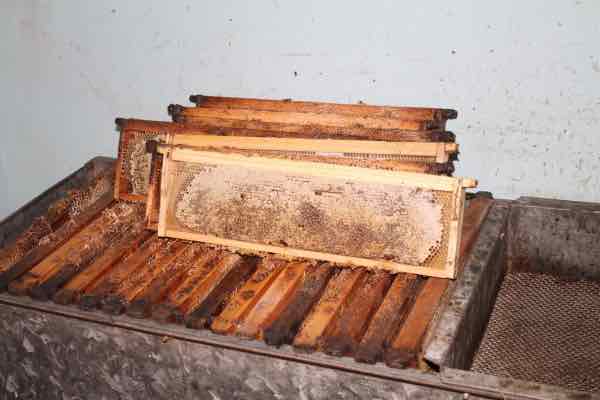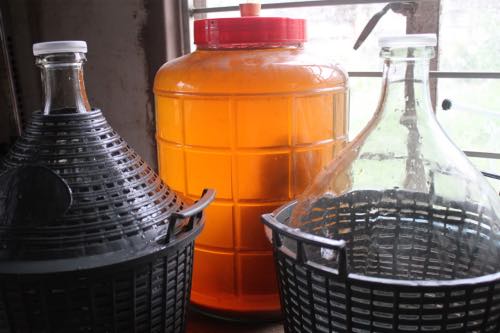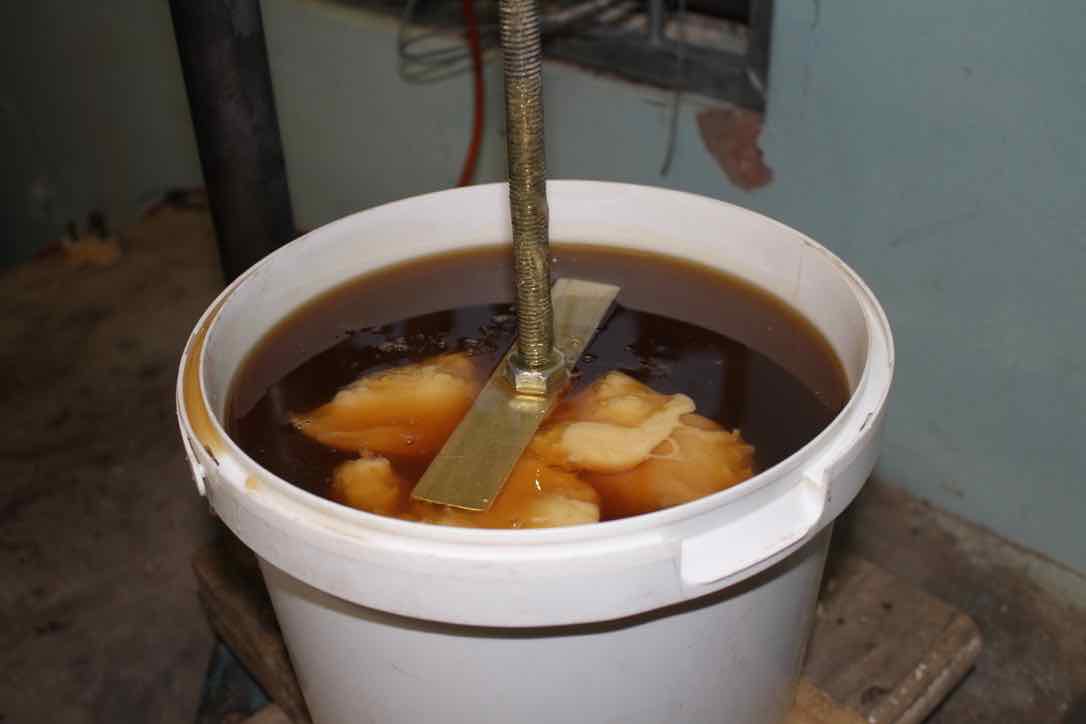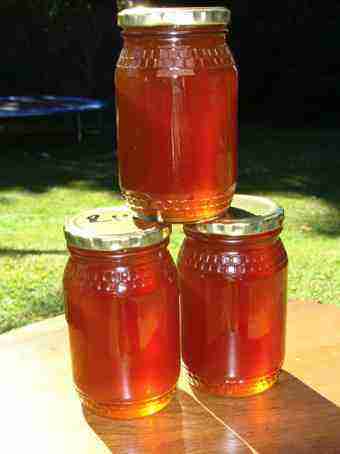- Bernard Preston homepage
- Beekeeping
- Modus Operandi Harvesting Honey
Modus operandi harvesting honey
Modus operandi harvesting honey will vary enormously according to your circumstances; are you extracting in your kitchen or do you have a dedicated-room?
Every professional beekeeper once started with a couple of hives in the back-garden. Noticing that which he produced was so much better than that from the supermarket, he began to expand.
Eventually he reaches ten-hives sometimes within a year or two. Now there is more honey than he can consume and give away as Christmas presents; he finds the family has some extra pocket-money. You could do it too.
I say "he" but many of our best beekeepers are women.

This page was last updated by Bernard Preston on 5th February, 2024.
It is many years since I wrote this page; none of the basics have changed. I have just harvested 150 pounds of beautiful unheated honey; not even warmed.
One development though is the brewing of mead. So I spin the combs before decapping; any unripe honey is fermented instead.
I have become anxious since reading that even one glass of commercial wine per week increases the risk of cancer; now we drink mead instead.

Two hives
If you have two hives then it is unlikely that you have a dedicated honey-room. You will want to harvest from both of your colonies, get everything processed and the kitchen spotless within a day; or you can expect trouble from the boss.
First warn the neighbours that you are planning on harvesting honey; make sure they don't have a garden-party planned.
So you will don your overalls, light the smoker and venture forth to the hives. Take a wheelbarrow and two empty-supers with you.
Having kitted-up and got the smoker burning properly, then gently waft a few puffs around the entrances of both hives. Wait for a while, giving them two or three minutes to ingest a little honey and quieten down; repeat a couple times.
Using your hive tool gently pry off the outer lid and then the inner-cover, taking your time so as not to upset the bees; smoking around and into the gap.
Smoke down between the combs and starting in the centre where there is most likely to be honey, pry out a frame, check it and gently shake the bees off back into the box. Then blow off any of the angry-critters that you can see and place it into the empty super on the wheelbarrow.
Remove all the frames that are at least two-thirds capped, going down through the supers and replacing with the frames from above that are not yet ready to be harvested. Don't be concerned if you find some brood; hot air rises and the queen loves to lay where it is warmer. The more the merrier wherever she places her eggs is our slogan.
Try to remove a whole super at least, if possible.
Then move onto the second and third colonies, consolidating the frames that are not completely capped. You can easily move them from one hive to the other, aiming for full supers on one of them even if you cannot achieve it; then you will not have to reopen the box.
Barrow the honeycombs to the kitchen; no more than three-supers to save your back. Blow off as many bees as you can before taking the frames inside, remembering that you are far more likely to be stung whilst processing the honey than down at the hives.
Uncap the frames, place them in the centrifuge and spin out the honey. You may need to turn them a few times if you do not have a radial extractor; otherwise the combs may break.
Before the extractor gets too heavy, raise it onto a shelf and drain off the honey, straining it through a coarse-sieve. If you do not have a bottling tank then get one; it is an essential.
I no longer strain it through muslin as I want the pollen to remain in the honey; it helps with allergies and a multitude of phytonutrients.
Once all the frames have been extracted, trundle them down to the hives and replace the now-empty combs. You could do it tomorrow.
Allow the honey in the tank to settle for a few days; scrape off the scum that rises to the top and bottle.
Clean the kitchen meticulously or you will no longer be welcome.
Modus operandi harvesting honey
Modus operandi harvesting honey is completely dependent on your circumstances; are you robbing 2 hives or 300?
Do you have a dedicated extracting room or will you be using the kitchen to process the combs?
Ten hives
By the time you get to ten hives, you will want to have a dedicated room where you can extract the honey and not infuriate the lady of the house.
Or are you the lady of the house?
Modus operandus 1
You can harvest the nectar from all ten hives before starting to uncap
and extract. Then you will have to work late into the night to get
everything done. You would want to complete the processing before the
honey becomes cold and difficult to remove from the combs. Do not leave some of it to the next day.
Modus operandus 2
I do it differently. My electrically-driven extractor holds 24 frames, so I open a few hives in the late afternoon and remove exactly the number needed; and process them immediately.
It takes about half an hour in the radial centrifuge for most of the honey to be extracted. Having strained it through a coarse sieve and poured it into the bottling tank, I can go to dinner.
The following afternoon, I will take the now empty frames down to the apiary and as I rob the next hives, I will replace the full honey combs with those extracted the day before; this saves a huge amount of work and means you do not need to disturb the bees twice.
So you choose which of the two methods of harvesting honey suits you best.
You may be doing your beekeeping in a built-up area; in the suburbs or even on an apartment rooftop. Did you know that city honey is better than that from the agricultural farmlands. It is far less likely to be contaminated with Roundup or the pollen from GMO crops.
Allow the honey to stand
The pressure within the bottling tank slowly forces bubbles and many of the tiny bits of wax that have penetrated the course sieve to the surface; you can then scoop it off. This pertains to both modus operandi of harvesting honey.
Then you have the option of keeping liquid honey; or creaming some of it.

Creamed clover honey is a world favourite.
100 hives
Once you reach 100 hives you have a little business that should produce a turnover in the region of half a million rand; a tidy supplement to your primary occupation. It is getting to the stage where you have to make a decision. Do you go full-time as a beekeeper and quit your other job?
The most I have ever had is 54 hives so this is rather speculative.
Then it will become more difficult to produce raw-honey. During the flow you will be harvesting several times a week; to get it filtered, settled and bottled before it crystallises really requires another pair of hands.
Does the good wife have an interest in the family business? Marketing 5000 jars of honey is a job in itself; then she could be her own boss instead of dragging herself off to the office every day.
The modus operandi harvesting honey remain much the same, only on a larger scale. Rob the honey from 10 hives say, uncap, extract and strain; and get all of it into settling-tanks before you go to bed.
The following day you take 15 odd empty-supers and harvest the next 10 hives, replacing the full frames with those that have been extracted as you go. You really need extra boxes of dry combs.
Both modus operandi of harvesting honey will work; and there are others, especially if your hives are far from your home.

When browsing use right click and "Open Link in New Tab" or you may get a bad gateway signal.
Newsletter
Our newsletter is entitled "create a cyan zone" at your home, preserving both yourself and Mother Earth for future generations; and the family too, of course. We promise not to spam you with daily emails promoting various products. You may get an occasional nudge to buy one of my books.
Here are the back issues.
- Lifestyle and ideal body weight
- What are ultra-processed foods?
- Investing in long-term health
- Diseases from plastic exposure
- Intensive lifestyle management for obesity has limited value
- A world largely devoid of Parkinson's Disease
- The impact of friendly bacteria in the tum on the prevention of cancer
- There's a hole in the bucket
- Everyone is talking about weight loss drugs
- Pull the sweet tooth
- If you suffer from heartburn plant a susu
- Refined maize meal and stunting
- Should agriculture and industry get priority for water and electricity?
- Nature is calling
- Mill your own flour
- Bake your own sourdough bread
- Microplastics from our water
- Alternative types of water storage
- Wear your clothes out
- Comfort foods
- Create a bee-friendly environment
- Go to bed slightly hungry
- Keep bees
- Blue zone folk are religious
- Reduce plastic waste
- Family is important
- What can go in compost?
- Grow broad beans for longevity
- Harvest and store sunshine
- Blue zone exercise
- Harvest and store your rainwater
- Create a cyan zone at your home
Did you find this page interesting? How about forwarding it to a friendly book or food junkie? Better still, a social media tick would help.
- Bernard Preston homepage
- Beekeeping
- Modus Operandi Harvesting Honey
Address:
56 Groenekloof Rd,
Hilton, KZN
South Africa
Website:
https://www.bernard-preston.com